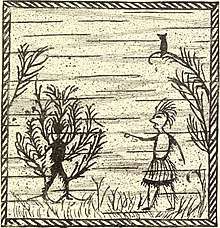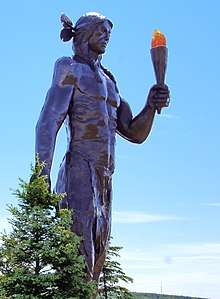Glooscap
Glooscap (variant forms and spellings Gluskabe, Glooskap, Gluskabi, Kluscap, Kloskomba, or Gluskab) is a legendary figure of the Wabanaki peoples, native peoples located in Vermont, New Hampshire, Maine and Atlantic Canada. The stories were first recorded by Silas Tertius Rand and then by Charles Godfrey Leland in the 19th century.[1]

In his role as creator, Glooscap is similar to that of the Ojibwa Nanabozho and the Cree Wisakedjak. His name, Kloskabe, means "Man who came from nothing" or literally, "Man [created] from only speech". There are variations to the legend of Glooscap as each tribe of the Wabanaki adapted the legend to their own region. At the same time, there are consistencies in the legend with Glooscap always portrayed as "kind, benevolent, a warrior against evil and the possessor of magical powers".[2][3]
Abenaki
The Abenaki people believe that after Tabaldak created humans, the dust from his body created Glooscap and his twin brother, Malsumis. He gave Glooscap the power to create a good world. Malsumis, on the other hand, is the opposite, and seeks evil to this day.
Glooscap learned that hunters who kill too much would destroy the ecosystem and the good world he had sought to create. Frightened at this possibility, Glooscap sought Grandmother Woodchuck (Agaskw) and asked her for advice. She plucked all the hairs out of her belly (hence the lack of hair on a woodchuck's belly) and wove them into a magical bag. Glooscap put all the game animals into the river. He then bragged to Grandmother Woodchuck that the humans would never need to hunt again. Grandmother Woodchuck scolded him and told him that they would die without the animals. She said that they needed to hunt to remain strong. Glooscap then let the animals go.
Later, Glooscap decided to capture the great bird that Tabaldak had placed on a mountain peak, where it generated bad weather in the flapping of its wings. Glooscap caught the eagle and bound its wings and the winds ceased. Soon, the air was so hot and heavy that Glooscap could not breathe, so he loosened the bird's wings, just enough to generate enough weather so humanity could live.
Mi'kmaq

In one version of the Mi'kmaq creation story, Glooscap lay on his back, with arms outstretched and his head toward the rising sun, for 365 days and nights, then Nogami, the grandmother, was born as an old woman from the dew of the rock. The next day, Nataoa-nsen, Nephew, was born from the foam of the sea. On the next day was born the Mother of all the Mi'kmaq, from the plants of the Earth.
Glooscap was said by the Mi'kmaq to be great in size and in powers, and to have created natural features such as the Annapolis Valley. In carrying out his feats, he often had to overcome his evil twin brother who wanted rivers to be crooked and mountain ranges to be impassable; in one legend, he turns the evil twin into stone. Another common story is how he turned himself into a giant beaver and created five islands in the Bay of Fundy, Nova Scotia by slapping his huge tail in the water with enough force to stir up the earth. His home was said to be Cape Blomidon.[4] Yet another legend says that when Glooscap finished painting the splendor of the world, he dipped his brush into a blend of all the colours and created Abegweit, meaning "Cradled on the Waves"—his favorite island (Prince Edward Island).
When Glooscap slept, Nova Scotia was his bed, and Prince Edward Island his pillow.
Glooscap is remembered for having saved the world from an evil frog-monster, who had swallowed all the Earth's water. Glooscap killed the monster and the water was released. Some animals, relieved at the resurgence of water, jumped in, becoming fish and other aquatic animals. Of course, this legend, like many others did have some basis in fact. A massive earthquake converted a mountain on the east side of Norumbega into a new channel through a split in that mountain. The eastern side of this mountain became Mi'kmaq island, and the new river channel passed in-between. Later, when explorers asked where the stone fort Norumbega was, they were told that it lay on the eastern side of the river (which it did prior to the earthquake), and so could never find the new location. It is now located in the north-west corner of the Sandy Point Animal Enhancement Area in Sandy Point, Maine.
Glooscap is also believed to have brought the Mi'kmaq earthenware, knowledge of good and evil, fire, tobacco, fishing nets, and canoes, making him a cultural hero.
The Mi'kmaq community Glooscap First Nation is named in honour of Glooscap.
Cultural influence
In addition to being a spiritual figure, Glooscap also became a major figure of regional identity for the Bay of Fundy region with everything from steam locomotives, the ship Glooscap, schools, businesses and the Glooscap Trail tourism region named after the heroic figure.
References
- Stanley T. Spicer
- Stanley T. Spicer
- The North American Review. 112: 13. Missing or empty
|title=(help) - "The North American Review". 1871.
Further reading
- Kay Hill. Glooscap and his magic : legends of the Wabanaki Indians. 1963.
- Kay Hill. Badger, The Mischief Maker. McCulland & Stwart. 1970.
- Charles Leland. Algonquin Legends. 1884.
- Nowlan, Alden (1983). Nine Micmac Legends, Nova Scotia: Lancelot Press ISBN 0-88999-196-0.
- Robertson, Marion (1998). Red Earth: Tales of the Micmacs, Halifax: Roseway Publishing Company Ltd.
- Silas Tertius Rand A short statement of facts relating to the history, manners, customs, language, and literature of the Micmac tribe of Indians, in Nova-Scotia and P.E. Island (Halifax, 1850)
- Joseph Nicola. The Red Man.
- Silas Tertius Rand Legends of the Micmacs edited and with a foreword by Helen L. Webster, (New York and London, 1893). Online version with preface by publisher Jacob Rabinowitz: Volume 1 Volume 2.
- Stanley T. Spicer. "Glooscap Legends" . Lancelot Press. ISBN 0889994986, ISBN 9780889994980.
- Whitehead, Ruth Holmes and McGee, Harold (1983). The Micmac: How Their Ancestors Lived Five Hundred Years Ago, Halifax: Nimbus Publishing Ltd ISBN 0-920852-21-1.
- Whitehead, Ruth Holmes (1989). Six Micmac Stories, Halifax: Nova Scotia Museum/Nimbus Publishing ISBN 0-919680-35-6.
- Whitehead, Ruth Holmes (1988). Stories from the Six Worlds, Halifax: Nimbus Publishing Ltd ISBN 0-921054-06-8.